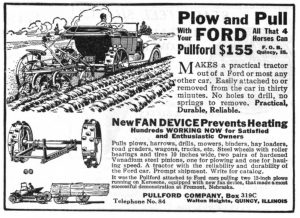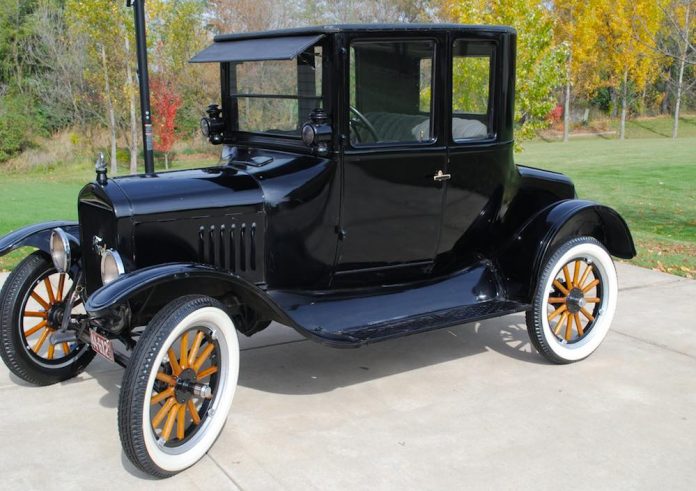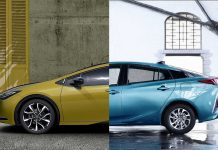You will probably never hear a TED talk about it, but the fact is the most autonomous car ever made was last made almost 100 years ago.
It was the Model T Ford – produced from 1908-1927.
Here was a car that did almost everything on its own – the defining essence of autonomous. It needed almost nothing from the external world except some gas in the tank. Not even a starter.
You were the starter.
Which meant that as long as you had at least one good arm and there was gas in the tank – gravity fed, so no worries about a fuel pump failing – you would probably not be walking.
It didn’t even have to have gas in its tank.
The Model T’s cast iron, 177 cubic inch four cylinder flathead engine could – and would – also run on alcohol or benzene or kerosene. Almost any combustible liquid would work in a pinch.
It was a “flex-fuel” engine decades before the term was coined.
The T wasn’t very fast – top speed was about 45 MPH – but the thing was hard to stop. It had skinny tires, transverse leaf springs and more than a foot of ground clearance, which enabled it to cut through snow drifts, traverse creeks and cross over almost any terrain – decades before such a thing as a “crossover SUV” was ever heard of.
You could use it to plow a field, if you liked.
Components were simple and rugged. Parts interchangeable.
Almost anything that went wrong with a Model T could be fixed by its owner – by the side of the road – and with the few basic hand tools that came with the car.
It was like a horse that never got tired. A faster, easier way to get from A to B – like a train – but capable of also going from A to C or D or Z, at its owner’s whim and on his timetable.
Ownership of a T made it feasible for people to spread out, however they liked.
You no longer had to live in town – or even near a town. Because now you could get to town – pretty much anytime you needed to.
Yourself.
Previously, Americans were more or less compelled to either live in town – or near enough to town – for a horse and buggy to get there in reasonable time. The T gave Americans the freedom to live and work almost anywhere; to come – and go – as they pleased.
As individuals.
The T gave its owner autonomy via mobility. The freedom to travel – anywhere, anytime. And affordably. Exactly what Henry intended. In his own words: 
“I will build a motor car for the great multitude. It will be large enough for the family, but small enough for the individual to run and care for. It will be constructed of the best materials, by the best men to be hired, after the simplest designs that modern engineering can devise. But it will be so low in price that no man making a good salary will be unable to own one – and enjoy with his family the blessing of hours of pleasure in God’s great open spaces.”
The man who bought a T was able to move around more easily; he could traverse great distances in less time than the average human being had ever been able to before.
He was also economically autonomous.
The T was so inexpensive – $825 in 1908 – that almost anyone who had a job, even a menial job, could afford to buy one. Previously, cars had been largely hand-built toys for the affluent.
Henry Ford made them practical tools for everyone.
With each passing year, more people could afford to buy one because the price of a T decreased with each new model year. By 1914, it cost just $440 to buy one.
By 1925, the same car cost $260 – about a third of its 1908 price (and only about $3,800 in today’s Fed inflated dollars).
Only the original VW Beetle – which consciously emulated the design principles of the T – ever approached the degree of autonomy achieved by the Tin Lizzie.
No, it did not drive itself.
But it did put millions of average Americans behind the wheel – giving them independent mobility – and thereby autonomy – the likes of which they’d never enjoyed before.
And which has been under assault lately – sickeningly, in the guise of hugely complex, massively expensive automated cars – the product of a government-corporate nexus designed specifically to control and thereby limit the individual’s mobility.
The driver reduced to mere passengerhood.
Allowed to travel from A to B, to the extent permitted by the external entities which exercise control over the automated car. You go only as fast as the programming permits and where and when and even if you’re allowed to go at all can easily be – and inevitably will be – limited by forces utterly beyond your control.
If it stops working, you stop moving. There is no more fixing the automated car yourself than there is driving it yourself. You are utterly dependent on the car – which controls you.
Which car is controlled by others, who aren’t even known to you.
This is “autonomous” transportation in just the way that the money forcibly taken from an unwilling victim is a “contribution.”
It is the antithesis of what Ford had in mind.
But it’s exactly where we’re headed.
…
Got a question about cars – or anything else? Click on the “ask Eric” link and send ’em in!
If you like what you’ve found here please consider supporting EPautos.
We depend on you to keep the wheels turning!
Our donate button is here.
If you prefer not to use PayPal, our mailing address is:
EPautos
721 Hummingbird Lane SE
Copper Hill, VA 24079
PS: Get an EPautos magnet (pictured below) in return for a $20 or more one-time donation or a $10 or more monthly recurring donation. (Please be sure to tell us you want a sticker – and also, provide an address, so we know where to mail the thing!)
My latest eBook is also available for your favorite price – free! Click here. 












One other thing about Henry Ford is that he was very disdainful of government. During his time, he refused to even sell his vehicles to government entities! He refused to take revenue from government sources, and didn’t even consider it a duty to help with war efforts. And this history relates strongly to why his company did as much as possible to refuse a government bail-out in 2007/2008.
really the only reasoning that makes any sense if that if you fall asleep or pass out and the car pulls over to the side of the road Otherwise youre either driving or your not.
I’ve got a picture of a totally electric car from more than 100 years ago; folks were smart back then, too.
Fantastic article. I totally dislike today’s cars with all the gismos and gadgets that can break down. About all you can do on your own is change the oil and filters. I don’t want to drive a car that drives me, controls me and passes on tons of info about where I go and how I get there or whatever. Privacy is going the way of the dodo bird as corporate America is on a mission to market us to death. Most people don’t like driving as they speed their way to wherever they are going in record time. I don’t mind driving and taking my time and enjoying the road. No way will I ever trust computers and autonomy to get me there safely. What happens when your vehicle malfunctions as some computer chip goes bazingo and causes a crash? Who will be at fault?
As a kid I drove a 1948 or 49 Chevrolet truck with a 216ci flat head engine, single barrel carb, 4 speed on the floor with a granny gear. You could pull the truck in two with that granny. To start turn key on, Press large spring loaded rod at left side of floorboard above the dimmer. No radio, I think it had a heater. Atmospheric cooling system. Dip and spray oil system. ‘Unsafe’ Bench seat. Great for dates with that floor shift. Easy, easy to repair. Fun as well for a 15 yo kid.
Some folks that I worked for at a big mountain resort had a whole bunch of those old trucks, some pickups and a couple dump trucks. One dump truck was a 46 and thus was the pre-war style and the other was a 47 and the “Advanced” series like everything up to 1955. They took the doors off of most of them so you could just jump in and out as you were working around the place.
I remember the starter button being just to the right of the gas pedal and you had to do a “heel and toe polka” sometimes to get them started. There were no starter solenoids but just a direct contact switch so the cable run from the under the passenger side floor to the switch to the starter was made as short as possible. I think my 1958 C-60 was like that also but now I don’t remember.
Excellent points made on this subject. You correctly use the term “autonomous” to mean the device can be user operated and maintained without third party involvement. The more current usage is a corruption since nothing done via AI is at the command and control of the user. Of course in the early days of IC engines and uses, few mechanics existed and parts and automotive shops were unavailable.
There is something very liberating about controlling your own destiny. In many Third World environments with terrible roads, infrastructure, etc. many vehicles sold today are cherished for their relative ease of repair with simple tools and minimal experience. In tough environments simple beats “better” every time. The AK-47 dominates the same markets for similar reasons though the AR series of American rifles is in many respects much better, lighter, etc.
The problem with every high maintenance product is that maintenance depends on a high level of civilization with working logistics and availability of technical experts at hand. We take that for granted and it is expensive. If we actually had a choice with vehicles, simple and cheap would still dominate for many who prefer self sufficiency and reliability. As Eric often notes, that $15,000 vehicle can’t be sold in “advanced” nations. Helplessness is instead sold as a “feature” , not a bug.
Eric, Great article as per usual. My grandfather worked in Detroit for Mr. Ford after living in an Iowa farm until he was 18. A real sod buster.
After he left Detroit – he ALWAYS bought a FORD- loyal to the last and until his death. My uncle worked in tool and die, but loved old cars – had several Model T’s, drove in parades and had them for us to ride in.
You bring back some emotions – but I miss the day of watching them work on the cars and riding in the Model T. Amazing man, Mr Ford.
(Mostly playing devil’s advocate)
Just going to mention there are open source initiatives for autonomous vehicles, with the goal to avoid many of the ownership and freedom of movement issues often raised here.
I don’t think we should be so quick to be against an autopilot-like system for automobiles. I understand that such systems would be abused by the “average driver,” but with the attitude of a driver as a vehicle manager I think these systems could be very useful. Driving down a highway with cruise control in use means you have to steer and avoid obstacles. Letting the vehicle do the steering means you still have to avoid obstacles, by taking control when necessary. Oh, I know that Google’s goal is to have a box with seats, and for uses like city busses that follow a very tightly controlled route I could see that happening, but for open road driving the ideal should be that of an aircraft autopilot. Just because the plane is “flying itself” doesn’t mean the pilot is in back chatting up the stewardess. There’s still a lot of attention paid to the situation, and both pilots are always ready to take over in case of an issue. Even something simple like excess turbulence will cause the captain to take over and fly manually, or at least make changes to the flight plan.
And let’s not forget liability and lawyers. Who’s responsible when the damn thing screws up? Or when your car get pwned by some script kiddie? We all know there will be EULAs out the wazoo with these things, and if there’s no override or manual controls, it’s all on them, not us. Oh sure, I’m certain some lawyer will argue that just getting into the thing absolves Google or Uber of any liability, but who the hell would ever agree to that? Having a manual override will be critical for these systems to get past that hurdle, since they’ll just argue that the driver should have taken control when the situation demanded it. Again, this will lead to a different style of driving and require a different level of training.
Mr Ford wrote books he would give away with every vehicle purchased which explain why things are the way they are….it’s title, The International Jew.
Also Kingsford charcole came from him…
Our old geniuses weren’t wrong on that issue.
Of course they were wrong, as are you. (Ol’ Henry recanted at the end and you’ll find plenty of “International Gentiles” responsible for the way things are.)
yeah I’m sure he would be thrilled about what the ford foundation turned into
Before it was stolen I had a Ford 9N on my mini farm. Man, I loved that thing! Essentially the same engine as the Model T or A. I could work on it with the hand tools I kept under one of the foot boards. My neighbor had a very up to date tractor with an enclosed cab, AC, stereo, and even GPS (he had a much larger piece of land). He never understood why I’d want that old tractor. But it did everything I needed and cost me less in repairs for a year than he spent every month in payments, and it was fun. And there was no proprietary code in my Ford.
Eh, I bought a 1951 Ferguson in 1977, which is nearly a copy of the 9N. Mine has an OHV Continental engine, 4-speed tranny. It’s very simple and easy to fix.
It dropped a valve in 2001, which went through the piston. I completely rebuilt the engine (did not remove crank but did put new main bearing inserts in) and it was no more difficult than rebuilding a lawnmower engine.
This post ^ was by “Bruce”
Good article, Eric. It brings back memories of stories my late father (1913-2000) used to tell me about Model Ts.
He grew up in Pa. where most roads were dirt (or mud) and everybody knew how to fix flats and and other basic problems on the road. A “day trip” back then was 50-75 miles.
The unpressurized radiator system would boil over and run dry by the time they got to the top of long hills. I guess nobody had figured out what to use to prevent freezing yet, so they had to drain the cooling system during the winter when they got home.
It seems he told me about somebody starting fires underneath the engine in the winter to warm it up so it would start. Maybe this was pretty common, not sure. I remember my father being amazed, sometime in the 1980s, how easily his car would start in the winter.
Also, if memory serves, if the gravity-fed fuel tank in the Model T (under the seat?) was low and you had to go up a steep hill, they would have to go in reverse so the fuel would feed into the engine.
But I don’t recall any stories about anyone he knew being killed or maimed in those cars, decades before Washington made them “safe.”
People wonder why I hang on to my aged 1980s cars and trucks. This article says it all.
Hi Ross,
Ditto.
My ’76 TA is half a century evolved from the T but still fundamentally the same. I control it. I can fix it. It makes me autonomous – not dependent.
What is scary to think about for me is that my first car (1965 Impala) is now older (were it still around) than the last Model T’s were when I got it in 1971.
Looks like you’re the highlight this morning at the libertarian international LIO Friends https://www.facebook.com/LibertarianInternationalOrganization/
One of your more brilliant articles Eric, with a single example you pointed out a great number of problems in the car industry.
Thank for the kind words, Maximus!
I was feeling off/tired the other day; thinking about the T helped to perk me up!
“It will be constructed of the best materials, by the best men to be hired, after the simplest designs that modern engineering can devise.” – WHAT?!? Unacceptable. Women and minorities MUST be equally represented, even to the detriment of quality!
Lol! I can hear the snowflakes now…they probably think it should be called the “Tin Lezzie”, just to make things “equal”.
The first “target” for these robotic vehicles will be the over-the-road, long-haul trucks. No one is more despised and hated by the TPTB than truck drivers. It just pisses them off that a man without a stack of “credentials” can earn a decent living in a job that doesn’t require college or some such. If one should encounter a robotic – controlled truck in the future, do anything you can to monkey-wrench it.
Hey Vince! Even worse, the over-the-road drivers tend to be pragmatic people with conservative leanings. The real kicker though, at least to TPTB, is that truck drivers often have long, uninterrupted periods of time when they are able to THINK. As we all know, thinking is the most dangerous thing a man can do!
Eric, you should check out the New Yorker, Apr. 30, “The Fight for the Right to Drive.” It talks about this technology and how it’s taking away human autonomy. There’s an organization called the Human Driving Association that’s fight it.
Anyway, the article made me think of this site.
Excellent article, Eric! Today’s automated cars being billed as “autonomous” is the epitome of Govt. “doublespeak” as described by George Orwell in his book “1984”. Political Correctness was the foundation of “doublespeak”, which began taking root in the US during the early 1980’s, ironically. Mindless submission to authority is only one small step away.
I call them robot cars. They are not autonomous, they are programmed to react to sensor inputs and follow orders. KITT they are not. I might be able to accept an artificial being in the form of car, but not a robot car.